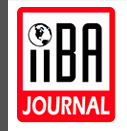Abstract
Women’s mobile banking adoption is linked to several advantages, including empowering women, enhancing investment in women-owned businesses, and decreasing extreme poverty.This study explores the demographic and socioeconomic characteristics that affect women’s mobile banking adoption in Bangladesh using Bangladesh Demographic and Health Surveys (DHS; 2020) data. In this study, 12,147 ever-married women aged 15-49 are included in the analysis. The chi-square test is used to examine the effect of socioeconomic and demographic factors on women’s mobile banking adoption. Then, the enter method of a binary logistic regression model is applied to identify the factors most strongly affiliated with it. The result shows that 14.8% (urban = 15.1% and rural = 14.6%) of women have adopted mobile banking services. The regression model reveals that women’s mobile banking adoption is significantly related to their age, education and occupation, husband’s education and occupation, livestock ownership, media exposure, and region. Women’s mobile banking adoption increased gradually with the increasing educational attainment of women. The study mentions that the Chi-square test of independence depicts a significant association between socioeconomic status and women’s mobile banking adoption, but the regression model shows an insignificant relationship between them. Respective banks should design their products and services to be more customer-friendly for people of different ages, education, professions, and geographical locations, especially women, and design push-pull services in the local Bengali language so that different levels of people, especially women, can understand. A future study can be done to address all demographic and socioeconomic characteristics that affect women’s mobile banking adoption.
Keywords
mobile banking adoption, demographic and socioeconomic factors, logistic regression analysis
Chinese Abstract
影响孟加拉国妇女使用手机银行的决定因素
使用手机银行对妇女有许多好处,包括增强她们的地位、促进妇女拥有企业的投资比例、以及减少极端贫困。本研究使用孟加拉国人口与健康调查(DHS,2020年) 的数据来分析孟加拉国妇女使用手机银行的人口和社会经济因素。本研究调查了 12,147名15至49岁的已婚妇女。该研究使用卡方检验方法来评估社会经济和人口因素对妇女使用手机银行的影响,然后使用二元逻辑回归模型的输入法来确定与之最相关的元素。结果显示,14.8%的妇女(城市=15.1%,农村=14.6%)使用了手机银行服务。回归模型显示,妇女使用手机银行与其年龄、教育和职业、丈夫的教育和职业、牲畜拥有量、媒体接触和地区有很大关系。随着妇女受教育程度的提高,使用手机银行的妇女比例逐渐增加。研究的独立性的卡方检验表明,社会经济地位与妇女使用手机银行之间存在显著关联,但回归模型显示两者之间的关系并不明显。各银行应设计更加方便顾客的产品和服务,以便满足不同年龄、教育程度、职业和地区的人群,尤其是女性人群。银行也可以当地孟加拉语设计推拉式服务,让不同层次的人(特别是女性)都能理解。未来的研究可以针对影响女性使用手机银行的所有人口和社会经济特征进行。
关键词: 手机银行应用、人口和社会经济因素、逻辑回归分析
ORCID Identifiers
Soma Dey: https://orcid.org/0009-0002-7029-9055
Sacchidanand Majumder: https://orcid.org/0000-0002-9197-0381
DOI
10.5038/2640-6489.9.1.1281
Recommended Citation
Dey, S., & Majumder, S. (2024). Determinants influencing the adoption of mobile banking by women in Bangladesh. Journal of Global Business Insights, 9(1), 61-76. https://www.doi.org/10.5038/2640-6489.9.1.1281
Creative Commons License

This work is licensed under a Creative Commons Attribution-Noncommercial 4.0 License


